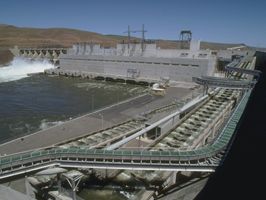forum
library
tutorial
contact

Managers Altering Water
Spilling at Two Dams
by Eric Barker
Lewiston Tribune, July 3, 2021
|
the film forum library tutorial contact |

|
Managers Altering Water
by Eric Barker
|
Changes at Lower Granite, Little Goose designed to cool down water for migrating salmon, steelhead
 Water and salmon managers opted Friday to halt normal summer spill operations at two dams on the Lower Snake in a desperate attempt to keep water temperatures from rising to dangerous levels in the midst of a blistering heat wave.
Water and salmon managers opted Friday to halt normal summer spill operations at two dams on the Lower Snake in a desperate attempt to keep water temperatures from rising to dangerous levels in the midst of a blistering heat wave.
If the strategy works, water at Lower Granite and Little Goose dams will be incrementally cooler in the short term, and the fish and water managers will extend their ability to cool the lower Snake further into August.
But the operation that could help adult sockeye over the next few weeks and returning fall chinook and steelhead in August and September may make conditions more difficult for juvenile fall chinook during their outmigration to the Pacific Ocean.
"It's tough," said Jonathan Ebel, a fisheries biologist for the Idaho Department of Fish and Game. "Trying to balance the short-term objectives and long-term objectives and the interests of adults and juveniles at any one point in time don't always align."
Endangered Snake River sockeye salmon have begun trickling over dams on the Snake and Columbia rivers. But they face river temperatures that are pushing into the low 70s in some spots in the hydropower corridor between Portland and Lewiston and even higher upstream. Temperatures above 68 degrees are considered harmful for salmon.
Idaho proposed the action and was joined by the Nez Perce Tribe in bringing it to the Technical Management Team, a group of state, federal and tribal fish, water and hydropower managers in the Columbia River basin. The forum meets weekly, and sometimes twice a week, during the spring and summer to manage water to help threatened and endangered Snake River salmon and steelhead while also trying to maximize power generation at federal hydroelectric dams.
Under the strategy that will be implemented starting today, the amount of water spilled at Lower Granite and Little Goose between 9 a.m. and 11 p.m. will be reduced by raising all but one spillway at each dam. Some water will continue to go over specially engineered weirs at the remaining spillway at each of the dams. The weirs are designed to attract juvenile fish.
The rest of the water that would normally go over spillways to help juvenile salmon move downstream will instead be directed through the powerhouse at the dams. That may help keep temperatures cooler because the intake for the powerhouse at each dams is about 30 meters deep, compared to just 10 to 15 meters deep at the spillways. The deeper water is cooler and reducing the spill also reduces mixing of warmer surface water with cooler water at depth.
It also means less water has to be released from Dworshak Dam on the North Fork of the Clearwater River about 70 miles upstream from Lower Granite Dam. Water released deep below the surface of Dworshak Reservoir is about 42 degrees and is used each summer in an attempt to keep temperatures of the Snake River below Lower Granite Dam at or below 68 degrees.
The reduced flows from Dworshak are important because the heat wave that produced seven consecutive days with temperatures at or above 100 degrees in Lewiston compelled the Army Corp of Engineers to begin the cool water releases nearly two weeks early and before the reservoir had refilled. That means the water that generally lasts through August will run out three to four weeks early this summer and just as adult fall chinook and some steelhead are pushing upriver. Modeling shows that for each 10 days the strategy adopted Friday is in place, it will lead to one additional day of cold water releases from Dworshak.
"Being able to extend the use of Dworshak cooling water is important, one could say critical, to adults," Ebel said.
The tradeoff is more juvenile fall chinook will go through hydroelectric turbines because of the reduced spill levels and fish travel time will be increased. Studies show the fewer powerhouses encountered by juvenile fish as they travel to the ocean, the better they survive to return as adults.
To compensate, the juveniles will be trapped as they move through powerhouses and taken downriver in trucks to be released below Bonneville Dam.
Many members of the forum expressed reservations because of the potential harm to juvenile fish, but ultimately either supported or declined to object to the strategy.
"We understand some of the concerns with altering the summer spill pattern and potential effects on juvenile fish and travel time," said Claire McGrath, of the National Oceanic and Atmospheric Administration. "Given the river conditions, river temperature management is our priority at this time."
Jay Hesse, director of biological services at Nez Perce Tribal Fisheries, said the action is designed "to make a bad situation a little less bad" and that even more actions are needed given the warming river temperatures and reduced flow volumes.
"The challenges that fish are currently facing and likely to face over the next several months are significant."
Both Hesse and Erick Van Dyke from the Oregon Department of Fish and Wildlife said fisheries managers will propose more changes in the coming weeks.
"This is the first step. There is going to need to be a lot of additional actions taken this summer," Hesse said.
learn more on topics covered in the film
see the video
read the script
learn the songs
discussion forum
